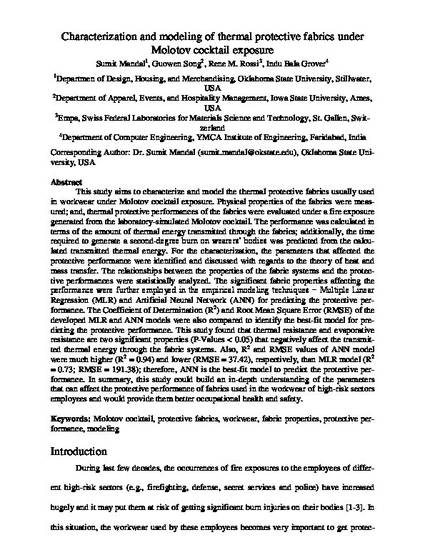
This study aims to characterize and model the thermal protective fabrics usually used in workwear under Molotov cocktail exposure. Physical properties of the fabrics were measured; and, thermal protective performances of the fabrics were evaluated under a fire exposure generated from the laboratory-simulated Molotov cocktail. The performance was calculated in terms of the amount of thermal energy transmitted through the fabrics; additionally, the time required to generate a second-degree burn on wearers’ bodies was predicted from the calculated transmitted thermal energy. For the characterization, the parameters that affected the protective performance were identified and discussed with regards to the theory of heat and mass transfer. The relationships between the properties of the fabric systems and the protective performances were statistically analyzed. The significant fabric properties affecting the performance were further employed in the empirical modeling techniques − Multiple Linear Regression (MLR) and Artificial Neural Network (ANN) for predicting the protective performance. The Coefficient of Determination (R2) and Root Mean Square Error (RMSE) of the developed MLR and ANN models were also compared to identify the best-fit model for predicting the protective performance. This study found that thermal resistance and evaporative resistance are two significant properties (P-Values < 0.05) that negatively affect the transmitted thermal energy through the fabric systems. Also, R2 and RMSE values of ANN model were much higher (R2 = 0.94) and lower (RMSE = 37.42), respectively, than MLR model (R2 = 0.73; RMSE = 191.38); therefore, ANN is the best-fit model to predict the protective performance. In summary, this study could build an in-depth understanding of the parameters that can affect the protective performance of fabrics used in the workwear of high-risk sectors employees and would provide them better occupational health and safety.
Available at: http://works.bepress.com/guowen-song/20/

This accepted article is published as Mandal S, Song G, Rossi RM, Grover IB. Characterization and modeling of thermal protective fabrics under Molotov cocktail exposure. Journal of Industrial Textiles. January 2021. doi:10.1177/1528083720984973. Posted with permission.